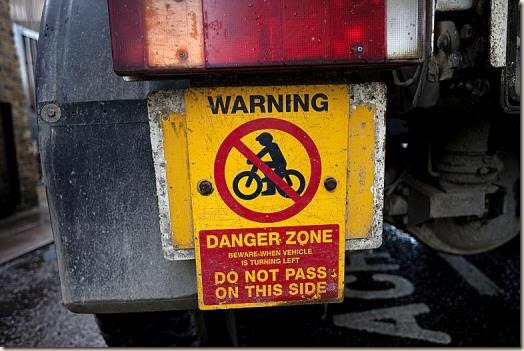I started writing this a few days ago, when the headlines were trumpeting that a FIFTH cyclist in a week had been killed after being involved in a collision with a bus in Whitechapel. I’ve had to edit it now, as another story (from Camberwell) now informs us that the tally has risen to SIX in two weeks. And I’ve had to edit it again now that Boris Johnson is beginning to see sense and realise that – shock, horror – the problem might not actually lie quite so completely with the motorist at all.
After the fifth fatality, Nick Clegg – aka Minnie Mouse in our Mickey Mouse government – called for cyclists’ “superhighways” to physically separate cyclists from traffic. Yes, Minnie – sorry, Nick – they’re known as “cycle paths” here on Planet Earth, and many cyclists – particularly those belonging to the Militant Spandex Morons Wing – refuse to use them (usually in order to show other road users that they can’t be told where they can and can’t ride). This is the mentality of the people involved, unfortunately (and as I’ve said before, I’ve ridden with them, and I see them daily, and I know that this is true for many of them).
When are people going to get it into their thick skulls that cyclists and motor vehicles don’t mix, and nothing anyone can realistically do will prevent such injuries if we continue to encourage the unholy alliance that has been borne out of the Olympics and two Tour de Frances?
In spite of what the Militants would have everyone believe – on pain of prosecution for disagreeing with them, of course – roads are for motor vehicles. They are not for prats in Spandex who think they are Bradley Wiggins, and who appear to inject testosterone every morning in order to develop just the right amount of anger and attitude needed to “do a 10k” to work. Earlier today, I was parked up reading some texts when one went by muttering angrily to himself about something (possibly it was directed at me, since it’s quite common to hear this as they push themselves along inappropriate roads at speed (as an aside, you may remember Emma Way – the girl who tweeted that she’d knocked a cyclist over. She has been found not guilty of careless driving)).
What makes the first London story especially irritating is that Boris Johnson is quoted:
There’s no question of blame or finger-pointing. That doesn’t work in these circumstances.
No, Boris. That’s because in this particular case the Finger of Blame isn’t pointing at the trucker. If there was even the slightest indication that the hapless driver was at fault, the Finger of Blame would be already turning the key in the remand cell door lock! And in that same story, there is a classic case of the tail wagging the dog as some dipstick is already banging on about banning HGVs in London “during rush hour”. He hasn’t considered that “rush hour” in London is a nebulous thing that can last anywhere from 6am until after midnight depending on what has happened on the M25 and other major roads in and around the City.
Many lorries have carried warning signs like the one above for a long time now. And yet cyclists continue to ignore them. The Militants can argue all they like, but in yet another example I experienced tonight, I was at the Nottingham Knight roundabout during busy rush hour. The busy A52 crosses this, and the road I was on has one straight ahead lane (on the right), and two left turn lanes. You have to look for gaps and take your chances confidently – which I did, only to discover that some complete wanker in Spandex had pulled up into one of the left turn lanes and actually tried to cut me up!
Let’s get this in perspective: he was in the wrong lane, and he tried to cut ME up – during rush hour… on a 60/70mph road junction!
There was absolutely no reason for me to suspect he would be there, and he damned nearly got knocked off. I had to move into the inside lane nearest the roundabout prior to exit and then cut back over. And I nearly crapped myself when I noticed him as I initially accelerated away. A large proportion of cyclists are total prats like this guy, and I’d confidently bet that this particular one was a fully paid up Militant. God knows why anyone would be so stupid as to try and ride across the Nottingham Knight roundabout on a bicycle in the first place, unless it was just to show that they can.
The latest two London deaths both involved cyclists colliding with lorries. For the record, the other four cases can be summarised:
5 November – Mile End Road – cyclist in collision with a tipper truck
11 November – Central London – cyclist in collision with a coach
12 November – Croydon – cyclist in collision with a bus
13 November – Bow Roundabout – cyclist in collision with a lorry
A total of 14 cyclists have been killed in London so far this year, and nine of those involved lorries (at least two of the others involved buses or coaches, which are basically lorries with a posh top, but which don’t figure in the media stats because they’re protected by virtue of their “greenness”). The Bow story also mentions a separate incident around the same time where a cyclist was injured after colliding with a truck. Likewise, the Camberwell story also mentions a separate non-fatal incident at around the same time involving a cyclist colliding with a lorry.
I’m sure many people will be aware of the parable of The Emperor’s New Clothes. Well, politicians like Peter John (leader of Southwark Council) clearly aren’t when they call for HGVs to be banned during rush hour. The latest accident in Camberwell happened at lunch time (as did the one in Croydon) – nowhere near the official “rush hour”. Lorries and rush hour are NOT the common denominators here. Cyclists are.
The Bow story contains a telling few words. I’ve quoted them here:
The London Cycling Campaign (LCC) held a protest at the roundabout on Wednesday evening… the gathered cyclists also circled the roundabout slowly on their bikes.
You can see that many of these people simply aren’t normal. Apart from riding around aggressively with cameras strapped to their heads in order to stir things up as they see fit (and you just have to look on a few of their websites to see that that’s exactly what they wear these cameras for), they happily engage in militant traffic-disruption of this nature. For normal people, if someone is killed in a road accident they may go and lay some flowers at the roadside, carefully parking up somewhere so they can walk the last short distance. But for cyclists it’s different. They have to block the road on purpose and turn the whole thing into a quasi-politico-religious event. If it wasn’t for the 21st Century skyline, you’d be forgiven for thinking you were watching a bunch of Neolithic cave people celebrating the solstice.
Cyclists are their own worst enemies. The vast majority have no road sense whatsoever (like the “expert” I had to avoid tonight, and you can read between the lines for yourself in the Emma Way case), and of those that do they have such a piss-poor attitude that it overrides anything else. A perfect illustration of this was on the BBC Breakfast News in the wake of the fifth London fatality. They had a militant cyclist up in the Glasgow studio giving his opinion, and they showed a video that he had apparently taken on the Bat-Cam in his helmet where he was nearly wiped out by a lorry as he negotiated a roundabout.
What they didn’t discuss was how fast he had entered the roundabout in the first place, with no sign of slowing down, and quite possibly with no intention of “giving way” to anything. They didn’t discuss how difficult it is for lorries to stop – especially when they are fully laden, and especially if they’re confronted with a fast-moving idiot on a bicycle. And they didn’t discuss whether he’d actually seen the lorry in the first place. I mean, let’s be honest here. If you are a pasty white meat-bag held together with Spandex, and riding a bike that weighs only a few kilogrammes, you need your bloody head examining if you deliberately race on to a roundabout with a lorry coming at you – and that applies whether you’re wearing your Bat Cape and stupid helmet with integral camera or not. Because if anything goes wrong – like it nearly did in the case of the guy on Breakfast News, and like it could have done with me tonight – you’re going to get splattered. Not the lorry or car. But YOU. It doesn’t matter who’s right and who’s wrong if you end up in the morgue.
The Highway Code says:
61
Cycle Routes and Other Facilities. Use cycle routes, advanced stop lines, cycle boxes and toucan crossings unless at the time it is unsafe to do so. Use of these facilities is not compulsory and will depend on your experience and skills, but they can make your journey safer.
69
You MUST obey all traffic signs and traffic light signals.
Laws RTA 1988 sect 36 & TSRGD reg 10(1)
71
You MUST NOT cross the stop line when the traffic lights are red. Some junctions have an advanced stop line to enable you to wait and position yourself ahead of other traffic (see Rule 178).
Laws RTA 1988 sect 36 & TSRGD regs 10 & 36(1)
72
On the left. When approaching a junction on the left, watch out for vehicles turning in front of you, out of or into the side road. Just before you turn, check for undertaking cyclists or motorcyclists. Do not ride on the inside of vehicles signalling or slowing down to turn left.
73
Pay particular attention to long vehicles which need a lot of room to manoeuvre at corners. Be aware that drivers may not see you. They may have to move over to the right before turning left. Wait until they have completed the manoeuvre because the rear wheels come very close to the kerb while turning. Do not be tempted to ride in the space between them and the kerb.
76
Full details about the correct procedure at roundabouts are contained in (see Rules 184 to 190). Roundabouts can be hazardous and should be approached with care.
77
You may feel safer walking your cycle round on the pavement or verge. If you decide to ride round keeping to the left-hand lane you should
- be aware that drivers may not easily see you
- take extra care when cycling across exits. You may need to signal right to show you are not leaving the roundabout
- watch out for vehicles crossing your path to leave or join the roundabout.
78
Give plenty of room to long vehicles on the roundabout as they need more space to manoeuvre. Do not ride in the space they need to get round the roundabout. It may be safer to wait until they have cleared the roundabout.
79
Do not ride across equestrian crossings, as they are for horse riders only. Do not ride across a pelican, puffin or zebra crossing. Dismount and wheel your cycle across.
82
Level crossings/Tramways. Take extra care when crossing the tracks (see Rule 306). You should dismount at level crossings where a ‘cyclist dismount’ sign is displayed.
The problem is that virtually all cyclists contravene at least some of these rules (and more besides). Hand signals are a thing of the past – even if they’re used at all, they’re done badly. The guy in Scotland who was nearly wiped out certainly didn’t decide that it would be “safer to wait” – he just pelted on to the roundabout in front of a lorry which would quite possibly have been unable to stop in time anyway. The prat I encountered today was certainly in the wrong lane and behaving dangerously. You see them riding on busy trunk roads when there is a cycle path less than a metre away from them. And they will skip red traffic lights or ride on to pavements to avoid them at the drop of a hat. They frequently ride more than two abreast – even on narrow country roads – when they’re in full-on testosterone mode, blocking traffic on purpose (and it IS on purpose, believe me). And we’re not talking about a small number of transgressors here. Either through bloody-mindedness or stupidity, a huge number of cyclists behave like this.
And the number of cyclists is growing.
When I’m teaching people to drive, I drum it into them early on that they should plan to stop at junctions and roundabouts, and treat being able to keep moving as a bonus, and only then after they have properly assessed the situation. As a driver, and as an instructor, there is nothing I hate more than going round a roundabout, only to have people pull out in front of me. Even if I don’t physically HAVE to hit the brakes, the fact my foot moves just in case is just as bad. But there are many cases where lorries have already committed themselves before I come into view, and since they weigh up to 40 tonnes they aren’t going to accelerate away very quickly anymore than they’re going to stop in the middle of the roundabout when they see me. So I slow down to let them go.
So why is it that cyclists think they have the right of way in these circumstances?
However, it seems that a modicum of reality is returning to the ridiculous situation created by the Olympics and Tour de France. After two years of idiots who think they’re Greenies trying to introduce some sort of racial cleansing programme against those who say a bad word about cyclists, a few people in high places are starting to see a glimmer of light – which others are still trying hard to extinguish. The third story reports that Boris Johnson has talked of banning headphones for cyclists – clearly implicating them in a number of incidents. The Militants have attacked this as you can imagine.
The simple fact is that if these cyclists weren’t next to the lorries or buses at the time then they wouldn’t have been hit. Now whether that means they were there because they’d ridden badly is open to debate, but since several of these accidents happened on corners it doesn’t take a genius to work out that that is a possibility.
In spite of this – and in spite of the photo shown above – Chris Boardman is now asking for a ban on HGVs.
Mr Johnson said there had to be a “much bigger conversation about HGVs” and the dangers they pose when they turn left.
But he said imposing a peak-time ban risked damaging London companies and creating a “serious influx as soon as the ban is over”.
Boardman is in cloud cuckoo land. Boris Johnson appears to have at last made contact with reality. The only thing that can definitely be said is that cyclists are clearly too stupid to follow rules and safety advice. It’s like putting labels on things like mattresses (e.g. “do not eat”) – except in the case of cyclists, some prat is trying to remove all motor vehicles from the equation.
Restrictions and rules need to be applied to cyclists. Cyclists need to abide by these rules by Law. And we need to stop encouraging cyclists to get on to busy roads. If they want to ride they should go to country parks and do it, or stick to cycle paths. By Law.



 Well done Peter, who passed first time on Tuesday with just 2 driver faults. He recently became a father, so now he can drive his son around without relying on his wife.
Well done Peter, who passed first time on Tuesday with just 2 driver faults. He recently became a father, so now he can drive his son around without relying on his wife. Well done Paula, who passed on Monday first time, with just 4 driver faults. Her dad had phoned me the night before because he’d taken her out and she’d had a stinker of a lesson with him (stalling and not looking). Yet she’d been perfectly OK with me the same afternoon, and none of the things he mentioned had happened when she’d been out with me on any lesson, let alone the last one before her test.
Well done Paula, who passed on Monday first time, with just 4 driver faults. Her dad had phoned me the night before because he’d taken her out and she’d had a stinker of a lesson with him (stalling and not looking). Yet she’d been perfectly OK with me the same afternoon, and none of the things he mentioned had happened when she’d been out with me on any lesson, let alone the last one before her test.
 You can donate in various ways, including via PayPal. You can donate any amount, so don’t be put off by the options presented if you can’t afford those. Every little helps.
You can donate in various ways, including via PayPal. You can donate any amount, so don’t be put off by the options presented if you can’t afford those. Every little helps. She’s the one who could break into tears over the smallest mistake or comment. The last three lessons before the test were no exception, either. I also discovered that with the tears comes argumentativeness! I shall remember the conversation about priorities at junctions – after we’d been doing them successfully for months – for a long time. It was like we’d never been in a car before, and I can’t remember the last time I had to terminate a Q&A session with something as autocratic as “Look! I challenge you to find me a junction which is laid out like that in the first place without there being traffic lights to control traffic flow across it”.
She’s the one who could break into tears over the smallest mistake or comment. The last three lessons before the test were no exception, either. I also discovered that with the tears comes argumentativeness! I shall remember the conversation about priorities at junctions – after we’d been doing them successfully for months – for a long time. It was like we’d never been in a car before, and I can’t remember the last time I had to terminate a Q&A session with something as autocratic as “Look! I challenge you to find me a junction which is laid out like that in the first place without there being traffic lights to control traffic flow across it”. that: she was speeding. Breaking the Law by driving too fast.
that: she was speeding. Breaking the Law by driving too fast.